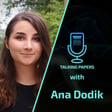
INR2Vec - Luca De Luigi
All links are available in the blog post: https://www.itzikbs.com/inr2vec/
In this episode of the Talking Papers Podcast, I hosted Luca De Luigi. We had a great chat about his paper “Deep Learning on Implicit Neural Representations of Shapes”, AKA INR2Vec, published in ICLR 2023 .
In this paper, they take implicit neural representations to the next level and use them as input signals for neural networks to solve multiple downstream tasks. The core idea was captured by one of the authors in a very catchy and concise tweet: "Signals are networks so networks are data and so networks can process other networks to understand and generate signals".
Luca recently received his PhD from the University of Bolognia and is currently working at a startup based in Bolognia eyecan.ai. His research focus is on neural representations of signals, especially for 3D geometry. To be honest, I knew I wanted to get Luca on the podcast the second I saw the paper on arXiv because I was working on a related topic but had to shelf it due to time management issues. This paper got me excited about that topic again. I didn't know Luca before recording the episode and it was a delight to get to know him and his work.
AUTHORS
Luca De Luigi, Adriano Cardace, Riccardo Spezialetti, Pierluigi Zama Ramirez, Samuele Salti, Luigi Di Stefano
ABSTRACT
pes, INRs allow to overcome the fragmentation and shortcomings of the popular discrete representations used so far. Yet, considering that INRs consist in neural networks, it is not clear whether and how it may be possible to feed them into deep learning pipelines aimed at solving a downstream task. In this paper, we put forward this research problem and propose inr2vec, a framework that can compute a compact latent representation for an input INR in a single inference pass. We verify that inr2vec can embed effectively the 3D shapes represented by the input INRs and show how the produced embeddings can be fed into deep learning pipelines to solve several tasks by processing exclusively INRs.
RELATED PAPERS
📚SIREN
📚DeepSDF
📚PointNet
LINKS AND RESOURCES
📚 Paper
💻Project page
SPONSOR
This episode was sponsored by YOOM. YOOM is an Israeli startup dedicated to volumetric video creation. They were voted as the 2022 best start-up to work for by Dun’s 100.
Join their team that works on geometric deep learning research, implicit representations of 3D humans, NeRFs, and 3D/4D generative models.
Visit https://www.yoom.com/
For job opportunities with YOOM visit https://www.yoom.com/careers/
CONTACT
If you would like to be a guest, sponsor or just share your thoughts, feel free to reach out via email: talking.papers.podcast@gmail.com
This episode was recorded on March 22, 2023.
#talkingpapers #ICLR2023 #INR2Vec #ComputerVision #AI #DeepLearning #MachineLearning #INR #ImplicitNeuralRepresentation #research #artificialintelligence #podcasts
🎧Subscribe on your favourite podcast app: https://talking.papers.podcast.itzikbs.com
📧Subscribe to our mailing list: http://eepurl.com/hRznqb
🐦Follow us on Twitter: https://twitter.com/talking_papers
🎥YouTube Channel: https://bit.ly/3eQOgwP



















